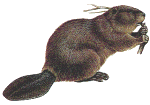
This is what is was all about......

This is what is was all about......
 BEAVER!!!!!
BEAVER!!!!! 
![]()
Some time in the late 1790s, men decided that they wanted to wear top hats, and the best "felt" for the hat came from an innocuous little creature called the Beaver. Being in short supply back "east", they were soon trapped out. So... men headed for the lands West of the Mississippi and to the Rocky Mountains hoping to strike it rich. Alas, the only ones who got "rich" were the fur trading companies... and many of them went under before a few emerged as leading the trade.
What sort of life did the Trapper have? It was sometimes a very short life if Bugs Boys The Blackfeet) caught him. If he managed to elude them, it was a very cold, miserable life for the most part. The Beaver plews were prime in the winter months... when the underfur was thickest. Typically, a trapper would wade out into icy water... usually mid-thigh deep... and set and lay the trap, and secure the trap to the holding stake. Coming back to shore, he would add the scent to his bait stick above the trap area, and go on to the next. Ideally they would lay a dozen or so traps. Come morning, they repeated the process all over again and took the Beaver from the traps that had been sprung and reset them. This went on from late fall (November) through the early Spring (late March). The trapper endured the possibility of Indian attack, bone numbing chill and frostbite, running afoul of ol' Ephram (Grizzly Bears), illness (usually pneumonia), accidents, and many other parts of Murphy's Law, just to claim his share of the wealth.
After skinning the Beaver, the trapper would flesh out the hide, and string it on a more or less oval willow hoop for it to dry. Once the hides were dried, they would be packed into roughly 100 pound packs using a Plew Press. This was a press that used a heavy weight to compress the plews into smaller bundles for easier handling by the trapper. Come late Spring, the trapper would load up his pack horses or mules, and set off for the annual gathering. This was called a Rendezvous, an invention of General William H. Ashley. Each year, at a pre-arranged place, the Fur Traders would meet the trappers and relieve them of their hard won Beaver. The Traders did not do this out of the kindness of their hearts... oh no. The provisions they brought with them were sold at greatly inflated prices (See Prices). An item that might have cost $2.00 in St. Louis was sold to the Trappers for three times that... sometimes more. Were the Trappers being cheated? Not really. The Traders took the risk of buying the goods and transporting them over a vast distance to the Ronnyvous. The Trappers figured it was better to pay their inflated prices than it was to take their furs all the way back to St. Louis and sell them, re-provision, then go all the way back to the mountains again. Both Trader and Trapper got what they wanted.
The Ronnyvous was usually in late June.... about mid summer, and ran for several weeks. When the last plew had been traded, when the last keg of whisky had been emptied, it was over, and the Trapper headed back to the mountains with his plunder, and the Trader head back to St. Louis. The average Beaver plew weighed about a pound and a half. In its hay-day, the price was as high as $8.00 a plew back East (the trapper being paid $6.00). At a $2.00 profit a plew, and the profit on the goods taken out to trade, many of the company owners became very rich. John J. Astor was one of these men.
